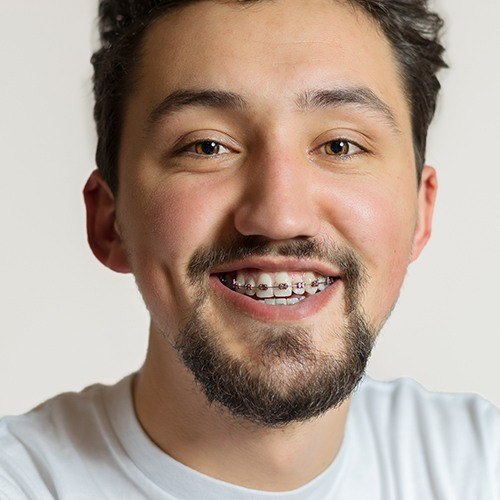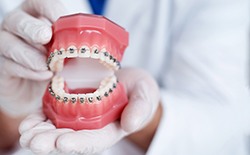Traditional Braces – Lacey, WA
Trusted & Individually-Tailored Orthodontics
Do you want to straighten teeth in Lacey, but aren’t sure what orthodontic treatment is the best choice for your unique situation? At Peterson & Cammack Family & Cosmetic Dentistry, we understand that every mouth is different, which is why we offer more than one solution to fix bite alignment problems, align teeth, and close gaps in your smile. With traditional metal braces, we’re able to help you achieve a flawlessly aligned grin and improve your oral health. That way, your mouth can function perfectly. If you’re interested in learning about how our custom-tailored orthodontic procedures can help you achieve your dream smile, contact our dental office for a consultation today to discuss traditional braces in Lacey, WA!
Why Choose Peterson & Cammack Family & Cosmetic Dentistry for Traditional Braces?
- Orthodontic Treatments for Teens & Adults
- Flexible Additional Financing Available
- Team of Two Experienced Dentists
How Do Traditional Braces Straighten Teeth?

Orthodontic treatments like traditional braces work by applying strategically placed pressure on certain areas of your mouth to slowly shift teeth into their ideal positions. Metal braces are comprised of multiple components including brackets, orthodontic bands, spacers, and an arch wire, to name a few. During your first appointment, our team of dental professionals will place all of these pieces in your mouth and adjust them accordingly every month or so.
We will move the wires to place additional pressure on the brackets if they begin to get lose from the movement of your teeth. Over the course of your treatment, we’ll do this repeatedly until each misaligned tooth has shifted into its ideal place in your mouth. For more complex cases such as bite problems, we may also include other components. After your treatment is complete, you’ll need to wear a retainer to ensure that your adjusted teeth stay in place.
Who is a Good Candidate for Traditional Braces?

Whether you’re a teenager or an adult, it’s never too soon or late to straighten your teeth and improve your oral health. Traditional braces can address a variety of orthodontic problems that are mild, moderate, and complex. We typically offer patients traditional braces if they’re looking to fix some of the following issues:
- Uneven spacing
- Crowded teeth
- Overbite, underbite, open bite, and crossbite
- Unmatched dental midlines
- Issues with chewing and speaking
- Jaw misalignment
The best way to learn whether you’re a good candidate for metal braces is to visit your dentist in Lacey for a consultation. Our team will walk you through your unique treatment plan and discuss what results you’d like to achieve after the procedure.
What are the Benefits of Traditional Braces?

In many cases, traditional orthodontics are a more effective and efficient solution. Here are some benefits you can enjoy when you get this cost-effective treatment:
- Strength: Metal is a strong material compared to ceramic and plastic, which are easier to break or damage. With traditional braces, you can reduce your risk of unexpected mishaps over the course of your treatment that set your timeline back.
- Affordability: Traditional braces remain one of the most affordable orthodontic treatment options.
- Versatile Treatment: Unlike other treatments, metal braces can tackle some of the most severe cases of misalignment, crowding, and bite problems, making them one of the most versatile solutions.
- Customizable: There are several different designs and colors that you can customize your metal braces with, adding some fun and variety into your treatment.
- Faster Treatment: You can treat complex issues more quickly with traditional braces.
If you’re on the fence about whether you would like to get traditional metal braces or you have any questions about the process, don’t hesitate to contact our dental office. Our team of friendly professionals will be more than happy to schedule a consultation so you can feel confident in your decision to straighten your smile with traditional orthodontic treatment.
Understanding the Cost of Traditional Braces

Before committing to orthodontic treatment, you likely want to know how much it’ll cost. Well, the overall price of traditional braces varies for each patient due to several factors. During your consultation, we’ll discuss your specific treatment costs and financial options to create a payment plan that’s within your budget. In the meantime, here are a few considerations to keep in mind.
Factors That Affect the Cost of Traditional Braces

The cost of traditional braces in Lacey depends on various factors, including:
- Severity of Misalignment – More significant misalignment requires more time for teeth to move, extending the duration of your treatment.
- Length of Treatment – Longer treatment times typically result in higher costs due to more frequent checkups, adjustments, and supplies.
- Age – Adult teeth are more firmly set in the jawbone compared to childhood or adolescence, potentially increasing treatment time and cost.
- Number of Follow-Up Appointments – Braces need adjustments every two to eight weeks based on patient progress, affecting overall cost.
- Additional Orthodontic Devices – Many patients require additional appliances like space maintainers, palatal expanders, elastics, headgear, or retainers.
- Treatment Compliance – Not following guidelines, such as wearing rubber bands as directed, can delay progress and extend treatment duration.
Professional Braces vs. “DIY” Braces: Which Costs More?

You may be tempted to save money with a "do-it-yourself" approach for a straighter smile. Recent trends have led to people using household and over-the-counter items like fishing lines, earring backs, superglue, and rubber bands to straighten their teeth. However, these methods can cause serious issues that require professional intervention, potentially costing you more in the long run.
Without professional guidance, you risk shifting your teeth incorrectly, misaligning your jaw, and damaging the soft tissues in your mouth. These complications can lead to significant problems that need correction. By choosing professional orthodontic care for traditional braces from the start, you can avoid these risks and save money in the long term.
Does Dental Insurance Cover Braces?

Dental insurance coverage for braces varies by plan. Many policies include coverage for traditional braces, especially if needed for medical reasons such as jaw misalignment or chewing difficulties. Typically, insurance may cover up to 50% of the cost, but this can differ based on your specific plan. Additionally, Health Savings Accounts (HSAs) and Flexible Spending Accounts (FSAs) can sometimes be used to help pay for treatment.
Options for Making Braces Affordable

Don’t have dental insurance? No worries! You can take advantage of additional financing options to make your treatment affordable. For example, we can help you apply for third-party financing through CareCredit. This way, the cost can be broken into smaller, more manageable monthly payments. Simply talk to one of our friendly team members to learn more!
Traditional Braces FAQs
How Do I Take Care of My Braces?
If you want treatment to go as smoothly and efficiently as possible, you’ll need to maintain your teeth and braces. First, avoid overly hard or crunchy foods, such as popcorn or nuts, as well as chewy foods like gummy candy or dehydrated fruit. If you have these foods, you risk damaging the brackets or getting food stuck in your braces.
After eating, it’s important to take a few minutes to brush and floss around the brackets and wires to remove any bits of food. In addition, you’ll need to slightly adjust your normal daily oral hygiene routine to accommodate your braces, but without these little habits, you could develop cavities or other complications.
Do Traditional Braces Hurt?
Orthodontic treatment entails shifting teeth within the jawbone, which requires quite a bit of force. As a result, treatment often involves soreness, specifically during the first week and for a couple of days after each adjustment. However, this discomfort subsides and indicates that your teeth are making positive changes! To ease soreness, we encourage having soft foods for a little while as well as taking over-the-counter pain reliever as needed. If your discomfort comes from irritation to your cheeks or lips, know that these tissues will become accustomed to the feeling of the brackets soon, but let us know if the irritation persists or if your braces ever feel painful.
How Long Does Treatment Take to Complete?
Each set of teeth requires a unique treatment plan, which comes with its own timeframe. However, the typical braces case can take between two and three years to complete. However, if your issues are minor, it may not take quite this long. When you meet with us, we’ll discuss your needs and talk about a projected timeline. Keep in mind that it will also depend on how well you follow instructions and stick to your treatment plan. For example, if you skip adjustment appointments, eat foods you shouldn’t, or develop cavities, your treatment plan may be delayed or extended.
What Happens After My Braces Are Taken Off?
Without braces to keep teeth in their new positions, they will try to revert and shift back. To prevent this from undoing all your hard work, you’ll need an appliance called a retainer. Although sometimes a retainer is permanently bonded to your teeth, most patients receive a removable retainer, which needs to be worn 24 hours every day—with the exception of when you eat and practice oral hygiene. After a while, which we will determine at a follow-up appointment, you may be able to wear the retainer only at night to preserve your results.